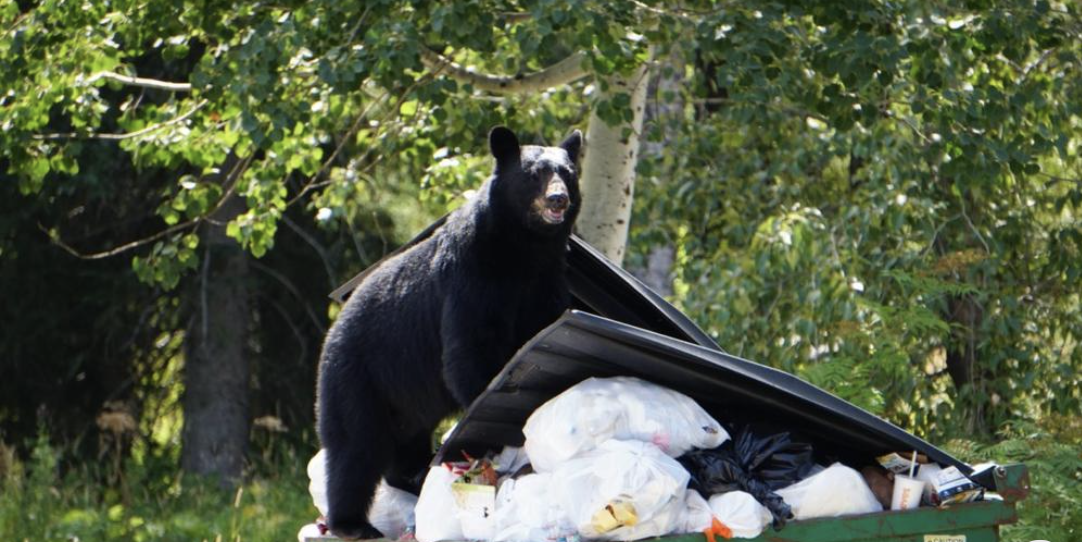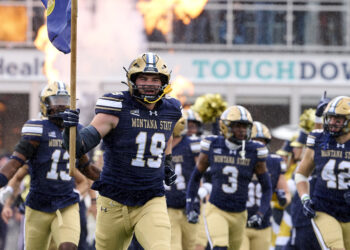Food-conditioned bears and an expanding human footprint in Missoula, Flathead and Gallatin valleys are creating problems for both species. Bear managers are on the hunt for solutions.
By Amanda Eggert MONTANA FREE PRESS
This story originally ran on montanafreepress.org.
A survey of bear headlines across Montana over the past two months reveals a perilous situation for animals that have become increasingly accustomed to living among humans: “Info sought on grizzly bear death near Seeley Lake”; “Hunters shoot and kill grizzly in self-defense encounter”; “FWP getting multiple calls per day about bear activity in Bozeman”; “UM student reports bear chase”; “Whitefish bear activity underscores need to secure garbage.”
Based on decades of experience, Missoula-based Montana Fish, Wildlife and Parks grizzly bear management specialist James Jonkel says his efforts to help human-bear relations are focused on training people, not bears. He describes his role as part social worker, and dispenses directions, often sprinkled with dry wit, to anyone who calls FWP’s west-central office for help dealing with grizzly or black bears clawing through their trash, plundering their fruit trees or raiding their beehives.
Jonkel said working with people to minimize conflicts with bears has taken on greater urgency as human expansion into wild landscapes has shrunk the size of secure bear habitat while simultaneously introducing a variety of attractants that encourage bears to roam in what he calls the urban wildlife zone. He said he and his counterparts in other regions of Montana find themselves trying to educate visitors and recently relocated homeowners who had no idea they had entered bear country. That’s especially true in recreation-oriented and mountain-adjacent areas like the Missoula, Flathead and Gallatin valleys, all of which have seen population growth and above-average bear conflicts this year.
“In the old days, we were [more careful] with our own food. …If we treated our food-related attractants like we do our money, we’d be a heck of a lot better off.”
JAMES JONKEL, MONTANA FISH, WILDLIFE AND PARKS GRIZZLY BEAR MANAGEMENT SPECIALIST
When Jonkel fields calls about bears near — and occasionally inside — Missoula homes, he immediately thinks apple tree, bird feeder, garbage, pet food. He tells the caller how food conditioning works, and how it puts both people and bears in danger. Sometimes that conversation is enough to change a resident’s behavior, but if further intervention is necessary, the next step is a site visit where Jonkel can offer a sharper admonition on the importance of securing attractants, or help identify an overlooked bear magnet.
Occasionally that involves a bit of detective work. Maybe mice have squirreled away dog food inside a wall. Or maybe rodent poison has drawn a bear into a shed, as was the case in an ultimately fatal (for the bear) Flathead Valley incident this fall. He counsels homeowners to treat their attractants — anything that might appeal to an opportunistic bear seeking calories, especially when they’re in pre-hibernation binge mode, as they are right now — like they treat their money: with special care.
“In the old days, we were [more careful] with our own food,” says Jonkel, who grew up accompanying his pioneering bear biologist father Chuck on work outings. “If we treated our food-related attractants like we do our money, we’d be a heck of a lot better off.” Expanding on the comparison, Jonkel said bears try to accumulate fat the way humans try to accumulate wealth.
“Some of these big adult bears will have an 8-inch-thick layer of fat over their hind end and a three-to-four-inch layer over their ribs, [plus] a lot of internal fat,” he said. “It’s their cash reserve.”
Part of Jonkel’s job is connecting people with resources to make their property less appealing to bears searching for calories to boost their fat reserves. He said there are lots of government- and nonprofit-administered grants to help fund mitigation measures that range from bear-resistant trash containers to electric fencing for beehives and chicken coops. Jonkel said he tries “to put the fear of God” into homeowners that a bear might have to be lethally removed — euthanized — if it continues to access attractants, variations on the “a fed bear is a dead bear” theme, a slogan that hearkens back to the 1970s. Most of the time, that helps drive the point home, since FWP callers rarely want to see a bear killed, Jonkel said, adding that his current favored slogan is “teach bears to stay away, not to come and stay. Prevention is the key.”
Despite his best efforts, Jonkel said, some bears behave like wayward teenagers — “They just have that glint in their eye like they’re going down the road to hell.” In those situations, he’s more likely to employ lethal removal. Euthanizing bears is often described by bear biologists as the worst part of the job, but Jonkel said it can be necessary to address emboldened bears that threaten public safety and private property. He said he’s had to lethally remove two grizzlies and four black bears in west-central Montana, FWP’s Region Two, this year. Property damage, bears entering homes or food habituation were to blame in all five cases, he said.
HABITUATING HUMANS
As grizzly populations grow and spread out into areas where they haven’t been seen in decades, public discourse about their management has become fraught, with some policy makers calling for heavier-handed management. This past legislative session, Montana lawmakers passed measures seeking to limit further grizzly expansion and attempting to broaden the circumstances under which people can legally kill grizzlies, which are federally protected under the Endangered Species Act.

Though landowners frustrated with property damage or livestock depredation sometimes center the conversation on the difficulty of dealing with increasingly habituated bears, Jonkel said the logic should work the other way, too: People living in bear country should familiarize themselves with their responsibilities in wild-adjacent ecosystems where large carnivores roam. That objective is on the agency’s radar more broadly. FWP spokesperson Greg Lemon said the department and other groups have been trying to come up with creative ways to get that message out to visitors and new Montana residents.
This fall the department put up a billboard on a flat, grassy stretch of urban sprawl along Interstate 90 in Billings — an hour-and-a-half drive from the closest grizzly population — featuring a photo of ursus arctos horribilis and the motto “Montana is grizzly country. Be prepared.” The billboard is one of four around the state aimed at raising awareness broadly, Lemon said. FWP also airs bear-awareness messaging on northwestern Montana radio stations and coordinates informational events and mitigation measures like carcass-pickup programs with volunteer-based neighborhood networks, and is developing educational campaigns for airports.
Another emerging objective for northwestern Montana’s Region One is reaching the short-term rental market, which includes more than 1,200 properties in Whitefish alone, and asking property managers to provide bear awareness introductions and advice to guests.
On the nonprofit side, People and Carnivores, a conflict-prevention group that works with western Montana landowners to deploy fencing and bear-hazing Karelian dogs, has started identifying homeowner associations in southwest Montana it hopes to work with as grizzlies expand their territory in the region. In anticipation of grizzlies repopulating the Bitterroot Valley, People and Carnivores in July hired a conflict prevention coordinator to work in the area, which has been visited by transient grizzlies the last few years and is expected to soon host its own resident population.

In Missoula’s Rattlesnake neighborhood, which abuts nearly 33,000 acres of wilderness, a local Girl Scout troop has even become involved. In coordination with the Great Bear Foundation, schoolchildren traversed the neighborhood last spring leaving doorknob hangers with tips for living in bear country.
Tim Manley, Jonkel’s FWP counterpart in the Flathead, said he and his colleagues with Flathead Bear Aware have tried some novel strategies, too, like connecting landowners who have apple, plum or pear trees on their property to eager fruit pickers via the Flathead Fruit Gleaning Facebook group to harvest a major bear attractant. And FWP has long tried to reach newcomers through real estate companies. Manley started speaking with agents about bears in 1993 and says the reception has been mixed — it turns out some agents aren’t keen on advertising proximity to one of North America’s apex predators among a property’s amenities. But Manely said he definitely sees a need for some sort of disclosure, having taken calls from people without a clue they’d relocated to grizzly habitat until they found one in their yard.
By mid-October, Manley said, FWP had captured 21 grizzlies in his area, with a quarter of the season to go before bears head into their dens. He said that’s above his yearly average of 17, but not an outlier. Some years the department will capture more than 30 grizzlies. Eight of this year’s captured bears have been euthanized and the rest were relocated.
October tends to be the busiest month for bear managers, and bears typically start denning around Thanksgiving, depending on food availability. By mid-December nearly all bears are hibernating.
Manley said huckleberry production in the mountains of northwestern Montana was spotty this year, so grizzlies moved into valleys — where the people tend to be — to feed on fall berry crops like hawthorne, chokecherries and serviceberries. Once there, many found a ready supply of ripe domestic fruit as enticement to stay.
Calls about black bears in the Flathead have been similarly hectic. In September alone, Region One received 615 bear-related calls. (In 2019, another above-average year for bear conflicts, the September call total didn’t top 300.) At one point last month, the department counted 19 black bears and one grizzly frequenting Whitefish’s urban center, according to Region One Information and Education Program Manager Dillon Tabish. He added that both regionally and statewide, current capture and euthanization statistics are a moving target, and final statewide numbers for bear relocations, euthanizations and other human-related mortalities won’t be available until the department completes its annual bear report in January.

“By this time next week, we’ll have our hands on a dozen more bears,” he said Oct. 20, referencing anticipated relocation operations to come.
In the Bozeman area as well, bear managers are reporting above-average conflicts, and the chief culprit in Gallatin Valley is unsecured garbage, according to Morgan Jacobsen, FWP’s information and education program manager for Region Three. He said he doesn’t have a ready count of bear relocations and euthanizations, but confirmed that FWP has euthanized more than a dozen black bears this year in the Bozeman and Big Sky areas. The fact that most of them have been in apparent good health — i.e., fat — suggests there’s no deficiency of wild food sources that’s driving bears into town, he said. Unsecured attractants appear to be the issue, he said.
Jonkel, Manley and Jacobsen all agree that minimizing bear conflicts requires an understanding of the dynamics and responsibilities that come with living in largely intact ecosystems. Jonkel says wildlife is adapting to human presence, and humans should be adapting to wildlife in turn. Otherwise, “it’s like a whole bunch of Greek tragedies going on everywhere.”
On a stage increasingly crowded with both human and bear protagonists, Jonkel says it’s going to be up to the humans to manage the plot. If people can’t learn to live with bears, they’ll learn to live without them, and that’s a future he’s trying hard to avoid.
“Good God, what a mess we have now — what’s it going to be like in 10 years, in 20 years, 100 years?” he said. “I still want to have this wildness in between all this crazy humanity.”
Billings native Amanda Eggert covers environmental issues for MTFP. Amanda is a graduate of the University of Montana School of Journalism who has written for Outside magazine and Outlaw Partners. At Outlaw Partners she led coverage for the biweekly newspaper Explore Big Sky. Contact Amanda at aeggert@montanafreepress.org.













